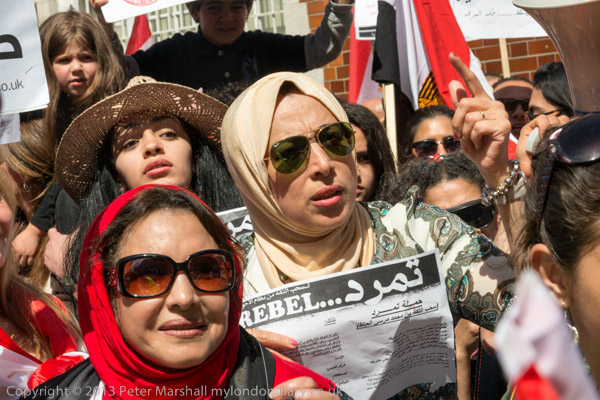
On 30 June there were mass protests in Egypt calling for President Morsi to go, with apparently a majority of Egyptians feeling he had betrayed the trust they put in him at his election. Egyptians in London joined in, several hundred going to the embassy for a noisy protest, and you can see my report and pictures in Morsi must go say Egyptian People.

Among them were many that I recognised from the protests in support of the Egyptian revolution, but it seemed clear to me that there were now more women in Muslim dress than at these previous events. I’m sure that there are Egyptians in London who support Morsi, but at least on this afternoon they were keeping a low profile. One man did come along, together with his wife in black with a baby buggy. I first noticed him talking to the police at the embassy door, then a few minutes later he stood and shouted from the edge of the protest, holding up pictures of the pro-Morsi protests. I took a picture from where I was with the 18-105mm, then moved through the crowd rapidly towards him. People were shouting back, and by the time I reached him police were leading him away, telling him if he wanted to protest he should do so somewhere else for his own safety. There were two rather smaller pro-Morsi protests by different groups at the embassy the following weekend, one of which ended abruptly when it was shouted down by people from the other, but I was busy with other issues, But perhaps he came back and joined in then.

It was a densely packed crowd, but a friendly one, with people readily making space for me when I indicated I wanted to move through to take pictures, and I was able to make my way to the centre of where things were happening with little problem. Once there, the most useful lenses were the ultra-wides, both the 16mm end of the 16-35 for a rectilinear view, and the fisheye view – around 140 degrees horizontal – of the 10.5mm, which, as usual I was using as a 16Mp DX lens on the Nikon D800E.
At times the ‘native’ view of this lens, which has a circular feeling, curving the msubject more as you move away from the centre of the image I think really adds to feeling of the crowd, but normally I work with this lens on the assumption that I will correct it to a different perspective. There are various ways you can do this, either using Lightroom’s own ‘lens corrections’, Photoshop and various plugins or other software. I find it best to choose one method and stick with it, keeping in mind the changes it will make when looking through the viewfinder, and my favourite is the ‘Fish-Eye Hemi’ plugin from Image Trends. Working with this in mind, the huge benefit is that the centre edges of the view finder show exactly what the extent of your frame will be after processing, but you have to remember that you will lose material from each of the 4 corners.
Lightroom’s built-in lens correction is generally hopeless. It defaults to ‘100’ which produces a rectilinear image, but only a smallish rectangle – perhaps a quarter of the image area – is really usable, and most of the image you saw in the viewfinder is simply lost. It actually does rather better if you crop the result from landscape to portrait, as it keeps the mid-top and mid bottom frame edges, resulting in an image in portrait format with around half the original horizontal angle of view. Sometimes a small value – perhaps 30 – can produce an interesting result, still with a pronounced curvature and also losing 10-15% of the horizontal field of view.
There is also other software that can be used to alter the perspective, including Photoshop itself, and plugins such as Panorama Tools and PTLens, as well as software designed to ‘de-fish’ images for panoramas including PtGui. I think these probably give better conversions to rectilinear than Lightroom but at the expense of a slower workflow. It’s probably possible to do almost anything with Panorama Tools if you devote sufficient time and effort and become a real geek.
But none of the ways of processing the fisheye images – apart from the ‘Fish-Eye Hemi’ give me something I can really work with predictably when using the camera. If anything the results it gives are more like what I actually see when looking through the camera, as somehow I am less aware of the curvature. The mind somehow corrects much of the ‘distortion’ producing a more natural impression in a rather similar way to the filter. I often mention this filter, and I don’t get paid for doing so – it’s just something that seems unique and works. Everyone with a 10.5mm should try it.
It is generally fairly obvious whether I’ve used the 10.5mm image ‘neat’ or processed in Fish-Eye Hemi in the pictures in Morsi must go say Egyptian People, but there is a simple way to tell if you are unsure. To apply the filter I first make corrections in Lightroom (particularly for chromatic aberration and fringing which are rather obvious with this lens) including any dodging and burning etc, then export a 16 bit copy to Photoshop to apply the filter. Lightroom renames the exported image, adding the suffix ‘-Edit’ to the filename. Browsers differ slightly, but right-clicking in mine gives an option ‘View image information’ which if chosen brings up a list with the current image name highlighted.
________________________________________________________
My London Diary : Buildings of London : River Lea/Lee Valley : London’s Industrial Heritage
All photographs on this and my other sites, unless otherwise stated are by Peter Marshall and are available for reproduction or can be bought as prints.
To order prints or reproduce images
________________________________________________________